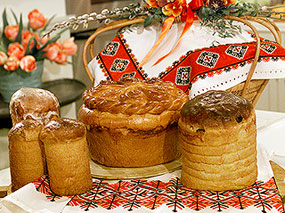Currently, churches on the Gregorian calendar calculate Easter as the first Sunday after the full moon that comes on or after the vernal equinox (March 21). This means that Easter can fall within a 35-day period between March 22 and April 25, inclusive. Churches that still use the old Julian calendar occasionally have Easter on the same Sunday as those on the Gregorian calendar, but through the different methods of calculation may celebrate Easter anywhere from one to five weeks later. This is due to a combination of factors including the thirteen-day lag behind the Gregorian calendar and the tradition that Easter must necessarily follow the Jewish Passover but must never precede or coincide with it.
On the Sunday before Easter, which is also called "Willow Sunday" branches of the willow tree (called loza) are blessed in the Church and given to the faithful. This particular ritual had a magical intent in pagan times. The willow tree had medicinal properties, was considered a holy tree, and was one of the first in the Spring to show signs of life. The people believed that by tapping each other with the freshly blooming willow tree branch, they could draw from it the same energy and strength which allowed it to come to life. The Christian Church on the other hand, marks this Sunday in accordance with the Gospel and the liturgical prescription celebrating the entry of Jesus into Jerusalem where he was greeted by throngs of people waving palm branches. To remember this event, the Church initiated a custom of distributing palm branches. The Ukrainian Church combined the ancient pagan ritual with the Christian one, with the difference that willow branches are given to the people instead of palm branches.
On the Sunday before Easter, which is also called "Willow Sunday" branches of the willow tree (called loza) are blessed in the Church and given to the faithful. This particular ritual had a magical intent in pagan times. The willow tree had medicinal properties, was considered a holy tree, and was one of the first in the Spring to show signs of life. The people believed that by tapping each other with the freshly blooming willow tree branch, they could draw from it the same energy and strength which allowed it to come to life. The Christian Church on the other hand, marks this Sunday in accordance with the Gospel and the liturgical prescription celebrating the entry of Jesus into Jerusalem where he was greeted by throngs of people waving palm branches. To remember this event, the Church initiated a custom of distributing palm branches. The Ukrainian Church combined the ancient pagan ritual with the Christian one, with the difference that willow branches are given to the people instead of palm branches.


E A S T E R




